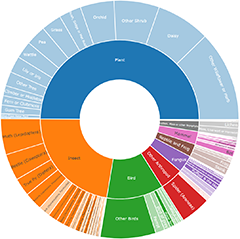Lichens
A lichen is a symbiotic partnership between a fungus and an alga or a cyanobacterium. The classification is based on the fungal partner and lichens are often referred to as lichenized fungi. The fungal partner may produce sexual spores and the most commonly seen spore-producing structure is the apothecium, usually circular and somewhat saucer-like. In a number of lichens the production of fungal spores is rare (or even unknown) so that only the vegetative component, or thallus, is present. Lichen thalli show various growth forms and the common types found locally are fruticose, crustose, foliose and squamulose. Fruticose lichens are erect or pendulous and markedly three-dimensional. Examples are Cladia and Usnea. Crustose lichens are markedly two dimensional and firmly attached to the substrate by their entire lower surfaces, making it impossible to see a crustose lichen's undersurface. A crustose lichen looks very much like a thin crust on the substrate and examples on NM are Buellia and Caloplaca. Foliose lichens could be thought of as halfway between crustose and fruticose. Though obviously three dimensional they grow in a more-or-less sheet-like form, but often with a lobed appearance. They are not attached by their entire lower surfaces to their substrates. Indeed, some foliose lichens are just centrally attached to their substrates with the rest loose, so making it possible to see both the lower and upper surfaces very easily. On CNM you will find examples in the family Parmeliaceae. Squamulose lichens grow as aggregations of small scales, from which the sporing structures may be produced. Examples already on NM are the genera Cladonia and Thysanothecium. Fruticose, crustose, foliose and squamulose are useful descriptive terms, not precisely defined taxonomic categories, and there are also other types of growth forms. Lichen expertise: Nature Map currently has no lichen expert on call. Heino, whose main interest is fungi, is able to identify a number of lichens to some degree but will be unable to say anything about most of the local lichens, even when superb photographs are presented. Hence, he is likely to give broad identifications of many photos, rather than have them sit indefinitely in 'Unidentified sightings'.
Further information: http://www.cpbr.gov.au/lichen/index.html
Announcements
There are currently no announcements.
Discussion
Unverified Lichen
Unverified Lichen
Teloschistes sp. (genus)
Top contributors
- Hejor1 367
- trevorpreston 284
- ConBoekel 187
- AlisonMilton 72
- Mike 58
- KylieWaldon 52
- JanetRussell 50
- mahargiani 45
- VanessaC 44
- KenT 38
Top moderators
- MichaelMulvaney 655
- Heino1 402
- Heino 127
- Teresa 29
- Pam 12
- MichaelBedingfield 4
- AaronClausen 2
- MartinPredavec 2
- RWPurdie 1
- AlisonMilton 1













































































